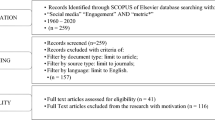Abstract
Recently, social networking sites such as Facebook and Twitter are becoming increasingly popular. The high accessibility of these sites has allowed the so-called social streams being spread across the Internet more quickly and widely, as more and more of the populations are being engaged into this vortex of the social networking revolution. Information seeking never means simply typing a few keywords into a search engine in this stream world. In this study, we try to find a way to utilize these diversified social streams to assist the search process without relying solely on the inputted keywords. We propose a method to analyze and extract meaningful information in accordance with users’ current needs and interests from social streams using two developed algorithms, and go further to integrate these organized stream data which are described as associative ripples into the search system, in order to improve the relevance of the results obtained from the search engine and feedback users with a new perspective of the sought issues to guide the further information seeking process, which can benefit both search experience enrichment and search process facilitation.









Similar content being viewed by others
Notes
References
Aggarwal C, Han J, Wang J, Yu PS (2003) A framework for clustering evolving data streams. In: Proc. 2003 Int. Conf. on Very Large Data Bases, pp. 81–92, Berlin, Germany
Babcock B, Babu S, Datar M, Motwani R, Widom J (2002) Models and issues in data stream systems. In: Proc. 21st ACM SIGMOD-SIGACT-SIGART Symposium on Principles of Database Systems, Madison, Wisconsin, USA
Bilenko M, White RW (2008) Mining the search trails of surfing crowds: Identifying relevant websites from user activity. In: Proc. WWW2008, Beijing, pp. 51–60
Bojars U, Breslin J, Finn A, Decker S (2008) Using the semantic web for linking and reusing data across web 2.0 communities. The Journal of Web Semantics 6(1):21–8
Buter B, Dijkshoorn N, Modolo D, Nguyen Q, van Noort S, van de Poel B, Ali Salah A, Akdag Salah AA (2011) Explorative visualization and analysis of a social network for arts: the case of deviantART. JoC 2(1):87–94
Chen H, Zhou XK, Man HF, Wu Y, Ahmed AU, Jin Q (2010) A framework of organic streams: Integrating dynamically diversified contents into ubiquitous personal study. In: 2nd International Symposium on Multidisciplinary Emerging Networks and Systems, Xi’an
Chi EH (2009) Information seeking can be social. Computer 42(3):42–6
Claudio Carpineto, Stanislaw Osiński, Giovanni Romano, Dawid Weiss (2009) A Survey of Web Clustering Engines. In: ACM Computing Surveys (CSUR), 41(3)
Ebner M (2009) Introducing live microblogging: how single presentations can be enhanced by the mass. Journal of research in innovative teaching 2(1):108–19
Ebner M, Lienhardt C, Rohs M, Meyer I (2010) Microblogs in higher education—a chance to facilitate informal and process-oriented learning? Comput Educ 55(1):92–100
Fang X, Liu Sheng OR (2004) LinkSelector: a web mining approach to hyperlink selection for web portals. ACM Transactions on Internet Technology 4(2):209–37
Gaber MM, Zaslavsky A, Krishnaswamy S (2005) Mining data streams: a review. ACM SIGMOD Record archive 34(2):18–26
Guha S, Meyerson A, Mishra N, Motwani R, O’Callaghan L (2003) Clustering data streams: theory and practice. TKDE special issue on clustering 15(3):515–28
Guha S, Mishra N, Motwani R, O’Callaghan L (2000) Clustering data streams. In: Proc. the Annual Symposium on Foundations of Computer Science. IEEE Press, California
Jagadish HV, Mumick IS, Silberschatz A (1995) View maintenance issues for the chronicle data model. In: Proc. ACM/PODS1995, pp. 113–124
Johnson KA (2011) The effect of Twitter posts on students’ perceptions of instructor credibility. Learning Media and Technology 36(1):21–38
Junco R, Heiberger G, Loken E (2011) The effect of Twitter on college student engagement and grades. J Comput Assist Learn 27(2):119–32
Klyuev V, Oleshchuk V (2011) Semantic retrieval: an approach to representing, searching and summarizing text documents. IJITCC 1(2):221–34
Ordonez C (2003) Clustering binary data streams with K-means. In: Proc. 8th ACM SIGMOD workshop on Research issues in data mining and knowledge discovery. ACM, San Diego, California, pp 12–9
Passant A, Bojars U, Breslin JG, Hastrup T, Stankovic M, and Laublet P (2010) An overview of SMOB 2: Open, Semantic and Distributed Micro-blogging. In:Proc. AAAI/ICWSM 2010
Passant A, Hastrup T, Bojars U, Breslin J (2008) Micro-blogging: A semantic web and distributed approach. In: Proc. ESWC/ SFSW2008, Tenerife, Spain
Poblete B, Baeza-Yates R (2008) Query-Sets using implicit feedback and query patterns to organize web documents. In: Proc. WWW2008, Beijing, pp. 41–48
Pyshkin E, Kuznetsov A (2010) Approaches for web search user interfaces: how to improve the search quality for various types of information. JoC 1(1):1–8
Reinhardt W, Ebner M, Beham G, Costa C (2009) How people are using Twitter during conferences. In: Proc. 5th EduMedia Conference, pp. 145–156. Salzburg, Austria
Signorini A, Segre AM, and Polgreen PM (2011) The use of twitter to track levels of disease activity and public concern in the US during the Influenza A H1N1 Pandemic. In: PLOS ONE, 6(5)
Srivastava J, Cooley R, Deshpande M, Tan P-N (2000) Web usage mining: discovery and applications of usage patterns from web data. ACM SIGKDD 1(2):12–23
Stumme G, Hotho A, Berendt B (2006) Semantic web mining state of the art and future directions. In: Elsevier Web Semantics: Science, Services and Agents on the World Wide Web, 4(2): 124–143
Ye Y, Li X, Wu B, Li Y (2011) A comparative study of feature weighting methods for document co-clustering. IJITCC 1(2):206–20
Zhou XK, Chen H, Jin Q, Yong JM (2011) Generating associative ripples of relevant information from a variety of data streams by throwing a heuristic stone. In: ACM ICUIMC2011 (5th International Conference on Ubiquitous Information Management and Communication), Seoul, Korea
Author information
Authors and Affiliations
Corresponding author
Rights and permissions
About this article
Cite this article
Zhou, X., Yen, N.Y., Jin, Q. et al. Enriching user search experience by mining social streams with heuristic stones and associative ripples. Multimed Tools Appl 63, 129–144 (2013). https://doi.org/10.1007/s11042-012-1069-1
Published:
Issue Date:
DOI: https://doi.org/10.1007/s11042-012-1069-1




